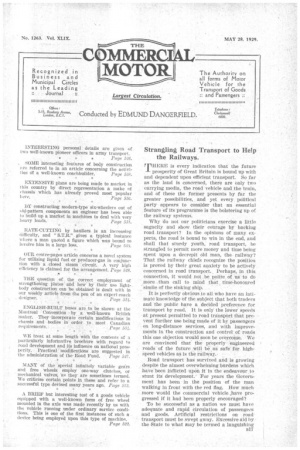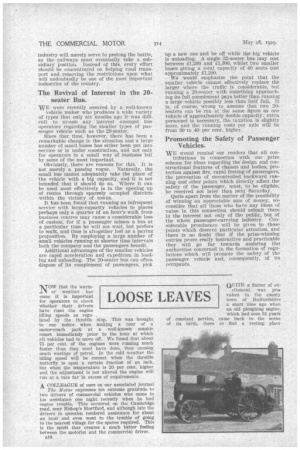Strangling Road Transport to Help the Railways.
Page 43

Page 44

If you've noticed an error in this article please click here to report it so we can fix it.
THERE is every indication that the future ^L prosperity of Great Britain is bound up with and dependent upon efficient transport. So far as the land is concerned, there are only two carrying media, the road vehicle and the train, and of these the former presents by far the greater possibilities, and yet every, political party appears to consider that an essential feature of ifs prograMme is the bolstering up of the railway systems.
Why do not our politicians . exercise a little sagacity and show their courage • by backing road transport? In the opinions of many experts, the road is bound to win in the end, and shall that sturdy youth.; road transport, be strangled to permit more money and time being spent upon a decrepit old man, therailway? That the railway chiefs recognize the position is proved by their great anxiety to be actively concerned in road transport.. Perhaps, in this connection, it would not be polite of us to do more than call to mind that time-honoured simile of the sinking ship.
It is perfectly obvious to all who have an intimate knowledge Of the subjea that both traders and the .public have a deCided preference for transport by road. It is only' the 1ovi7er speeds at present permitted to road transport that prevent further Use being made of it by passengers on long-distance services, and with improvements in the construction and controlof roads this one objection would soon beovercome. We are convinced that the properly engineered roads of the future will -be. as' safe' for highspeed vehicles as is the railway...
Road transport has survived. and is growing despite the almost overwhelming burdens which have been indicted upon it in the endeavour to stunt its development.' For years the 'Government. has been in the position of the man walking in front with the red flag. How much more would the commercial vehicle _have progressed if it had been properly encouraged?
To be successful as a nation we must have adequate and rapid Circulation of passengers and goods. Artificial restrictions on road' transport must be swept away. Excessive aid by • the State to what may be termed a languishing industry will merely serve to prolong the battle, as the railways must eventually take a subsidiary position. Instead of this, every effort should be concentrated on helping road transport and. removing the restrictions upon what will undoubtedly be one of the most important industries of the country.
The Revival of Interest in the 20seater Bus.
WE were recently assured by a well-known vehicle maker who produces h wide variety of types that only six months ago it Was diffi cult to arouse any interest amongst bus operators regarding the smaller types of passenger vehicle such as the 20-seater.
Since that time, however, there has been a remarkable change in the situation and a largo number of small buses has either been put into service or is under construction, and not only for operators in a small way of business but by some of the most important.
Obviously, there are reasons for this. It is not merely a passing vogue. Naturally, the small bus cannot adequately take the place of the vehicle with a big capacity, and it is not intended that it should do so. Where it can be used most effectively is in the opening up of routes through sparsely occupied districts within the vicinity of towns.
It has been found that running an infrequent service with large-capacity vehicles to places perhaps only a quarter of an hour's walk from business centres may cause a considerable loss of custom, for if a passenger misses a bus at a particular time he will not wait, but prefers to walk, and thus is altogether lost as a paying proposition. By employing a large number of small vehicles running at shorter time intervals both the company and the passengers benefit.
Additional advantages of the smaller, vehicles are rapid acceleration and expedition in loading and unloading. The, 20-seater bus mu often dispose of its complement of passengers, pick up a new one and be off while the big vehicle is unloading. A single 32-seater bus may cost between £1,200 and £1,300, whilst two smaller buses giving a total capacity of 40 seats cost approximately £1,200.
We would emphasize the point that the smaller vehicle cannot effectively replace the larger where the traffic is considerable, but running a 20-seater with something approaching its full complement pays better than running a large vehicle possibly less than half full. It is, of course, wrong to assume that two 20seaters can be run at the same figure as one Vehicle of approximately double capacity ; extra personnel is necessary, the taxation is slightly more, and the running costs per mile will be from 30 to 40 per cent. higher.
Promoting the Safety of Passenger Vehicles.
WE would remind our readers that all con tributions in connection with our prize scheme for ideas regarding the designand constructional features of chassis and bodies, protection against fire, rapid freeing of passengers, the prevention of uncontrolled backward running and other points which directly affect the safety of the passenger, must, to be eligible, be received not later than next Saturday.
Quite apart from the matter of the possibility of winning an appreciable sum of money, we consider that all those who have any ideas of value in this connection should submit them . in the interest not only of the public, but of the whole passenger-carrying industry. Considerable prominence will be given to those Points which deserve. particular attention, and there is no doubt that if the prize-winning entries prove really instructive and practicable they will go far towards assisting thej authorities concerned in the formation of regulations which will promote the safety of the passenger vehicle and, consequently, of its occupants.




















































































































